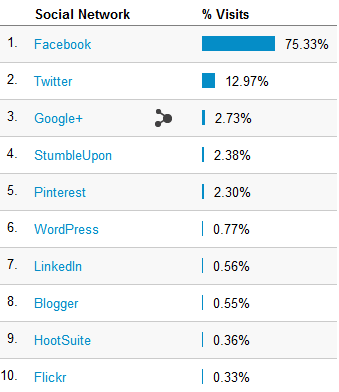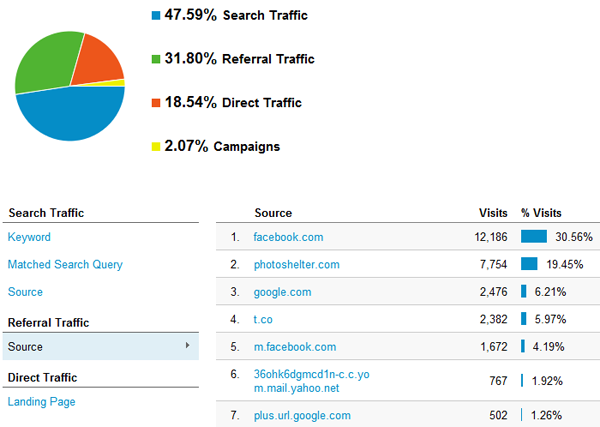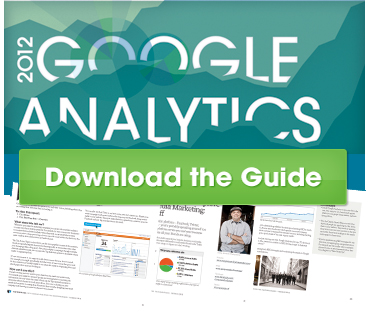Share
How Much Does Social Media Really Matter?
You tweet links to your most recent work; post a teaser image from your new gallery to Facebook; and maybe even promote your latest blog post on Go...
You tweet links to your most recent work; post a teaser image from your new gallery to Facebook; and maybe even promote your latest blog post on Google+. But if you’re not checking out how these social media efforts are driving traffic to your website, then it’s somewhat of a loss cause. Sure, you can track how many retweets, likes, or +1’s your posts receive, but if your goal is to get people to your website (where they can ultimately become customers or clients) then these stats tell you nothing.
If you spend a considerable amount of time promoting yourself on social media (you know who you are!), then take a vow to stop tweeting, Facebook posting, pinning – whatever – until you adopt a measured, analytical approach to your marketing efforts. How? Install Google Analytics on your website – and then make the tool your best friend.
Our free guide, Google Analytics for Photographers, breaks down 10 ways to improve your photo business using analytics. Below is a snapshot of one: how to determine if social media drives traffic your site.
Here’s how it works: Google Analytics breaks down your site’s traffic into four main sources, one of which is referral traffic. Referral traffic accounts for visitors who come to your website by clicking a link on another site – and social media platforms are likely to be some of the top referring domains. Smart marketers take note of which sites drive the most traffic, and then spend the majority of their resources (i.e. time and money) working to optimize their efforts there.
Check out your referral traffic by viewing the Traffic Sources Overview Report in Google Analytics, and then clicking on Referral Traffic > Source to see the percentage breakdown of which sites are driving traffic to your website.
If referral traffic makes up a considerable amount of your site’s overall traffic (let’s say 15% or more), then it’s well worth your time to dive deeper and determine which platforms are driving the most visitors. Head over to the Social Overview Report, which can be found under the Traffic Sources Report, to see your social network visits breakdown.
 Use the Social Overview Report to determine the top 10 social media platforms that are driving traffic to your website.
Use the Social Overview Report to determine the top 10 social media platforms that are driving traffic to your website.
Depending on your social media strategy, you might not be surprised at what comes up – in the example above, we’re not totally shocked that 75% of all social media referral traffic comes from Facebook, given its enormous presence in the photo community. However, you might also notice some new social media players like Pinterest and Tumblr making a stand.
Architectural photographer Lincoln Barbour, who gets about 20% of his site’s overall traffic from social media, says that Pinterest has accounted for a huge boom in his traffic and has even had a few indirect sales from his pins (Pinterest-speak for posts). In fact, after Facebook, Pinterest is driving the most social referral traffic to his website. “My architecture and food work is very in line with the average Pinterest user,” says Lincoln. “So anything I put up there gets popular pretty quick, which brings people to my site. If only a few of them are buyers, it’s totally worth the effort.”
Lincoln notes that he wouldn’t have known Pinterest was driving new site visitors if it wasn’t for Google Analytics. “I now fully embrace Pinterest,” says Lincoln, and he uses it to promote his blog posts, portfolio, and PhotoShelter archive.
St. Louis-based photographer Corey Woodruff is another heavy Google Analytics user who diligently tracks his website’s incoming traffic. Over 40% of Corey’s overall traffic is referral, the majority of which comes from social media sites like Facebook, Twitter, and Flickr. Google Analytics has also revealed new sites that link to Corey’s food photography. “Foodgawker and Tastespotting have sent some traffic my way, which is interesting because I have never directly posted to them,” he says.
Noting these new sources of referral traffic has helped Corey fine-tune the content on his website and blog. He found that webpages with his personal photo projects tend to have greater average visit duration (i.e. how long someone spends visiting your website), which is likely because all these images have captions that people are choosing to read through.
It’s this kind of deeper insight into Google Analytics that can help photographers figure out where their time is best spent. To get the full 10 Ways to Improve Your Photo Business with Google Analytics, download our free guide – Google Analytics for Photographers. We indicate whether each step is easy, medium, or complex in nature so that photographers of varying technical experience can take actionable steps to improve their marketing efforts.







